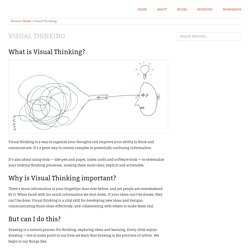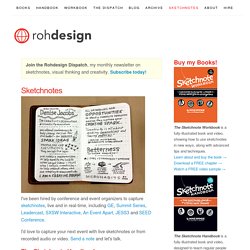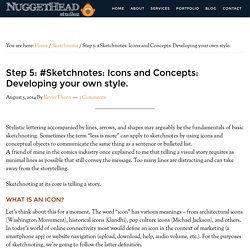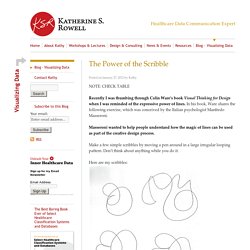

Visual Thinking. What is Visual Thinking?

Visual thinking is a way to organize your thoughts and improve your ability to think and communicate. It’s a great way to convey complex or potentially confusing information. It’s also about using tools — like pen and paper, index cards and software tools — to externalize your internal thinking processes, making them more clear, explicit and actionable. Why is Visual Thinking important? There’s more information at your fingertips than ever before, and yet people are overwhelmed by it. But can I do this? Drawing is a natural process for thinking, exploring ideas and learning. “I’m no artist” “I can’t draw a straight line” “I can’t draw a stick figure” This is a fallacy. Don’t believe me? Visual Thinking basics In this 20-minute video I share some basics of visual thinking that will get you up and running in about 20 minutes. Visual Thinking.
Sketchnotes - Designer Mike Rohde. I've been hired by conference and event organizers to capture sketchnotes, live and in real-time, including GE, Summit Series, Leadercast, SXSW Interactive, An Event Apart, JESS3 and SEED Conference.

I'd love to capture your next event with live sketchnotes or from recorded audio or video. Send a note and let's talk. The Sketchnote Handbook I wrote The Sketchnote Handbook with Peachpit Press (November 2012). The book teaches ways regular people can use sketchnoting techniques to make note-taking more memorable and more fun. The Sketchnote Workbook The Sketchnote Workbook is a follow-up to The popular Sketchnote Handbook, with more ways to use sketchnoting to visually capture ideas, experiences and information.
Step 5: #Sketchnotes: Icons and Concepts: Developing your own style. - Nuggethead Studioz. Stylistic lettering accompanied by lines, arrows, and shapes may arguably be the fundamentals of basic sketchnoting.

Sometimes the term “less is more” can apply to sketchnotes by using icons and conceptual objects to communicate the same thing as a sentence or bulleted list. A friend of mine in the comics industry once explained to me that telling a visual story requires as minimal lines as possible that still convey the message. Too many lines are distracting and can take away from the storytelling. Sketchnoting at its core is telling a story. Let’s think about this for a moment. Again, considering today’s definition or perception, an icon’s job is to simply communicate. Speaking of symbols (which is an entirely different conversation), there are many in the English alphabet that have taken on new meanings in recent years.
In terms of sketchnoting, let’s start with a symbol and its meaning. Learning how to quickly sketch icons while in the middle of sketchnote takes practice. The Power of the Scribble. Recently I was thumbing through Colin Ware’s book Visual Thinking for Design when I was reminded of the expressive power of lines.

In his book, Ware shares the following exercise, which was conceived by the Italian psychologist Manfredo Masseroni. Masseroni wanted to help people understand how the magic of lines can be used as part of the creative design process. Make a few simple scribbles by moving a pen around in a large irregular looping pattern. Don’t think about anything while you do it. Here are my scribbles: Now comes the fun part.
Transform your scribbles into birds by simply adding a small, dark circle and a < shape to any one loop of the scribble. What is extraordinary about this exercise is that just about any scribble can become a bird. Here are my scribbles transformed into birds: This exercise is of course a great way to amuse small children and fill awkward silences at cocktail parties…(so killer to a great party). First, it highlights the useful and valuable power of seeing. The Sketchnote Workbook - Designer Mike Rohde. The Sketchnote Workbook is a fully-illustrated book and video, showing how you can use sketchnotes in your everyday life to capture ideas, plan projects, document processes, and capture memorable experiences.

The Sketchnote Workbook, the follow-up to the popular Sketchnote Handbook, shows you how to take the basic sketchnoting skills you learned in the Handbook and use them in new and fun ways. You think you have fun taking sketchnotes in meetings? Try using them to record your travels. Or start a food journal. Or break out those visual notetaking skills in your next brainstorming session–whether you're at work or school, or just trying to figure out how to organize the paper that’s due next week. Don't worry. 9780133831719. Sketchnoting. 0321857895.pdf. Tools. Sketcho Frenzy: The Basics of Visual Note-taking. A Sketchnote Primer. Why and How to Start Sketchnoting, IA Summit 2012. How and Why to Start Sketchnoting. Sketchnoting (Kathy Schrock) Sketching Concepts.